Spectroscopic Investigation of Wall Paintings in the Alhambra Monumental Ensemble: Decorations with Red Bricks
Abstract
1. Introduction
2. Materials and Methods
2.1. Description of the Sites of Study
2.1.1. Indoor Locations
- Casitas del Partal (Partal Dwellings)–Torre de las Damas (Tower of the Ladies, TL)
- Baño del Palacio de Comares (The Bath of Comares Palace, BC)
- Torre de las Infantas (Infant’s Tower, IT)
2.1.2. Outdoor Locations
- Patio del descabalgamiento (Court of the Dismount, CD)
- Casa de Astasio de Bracamonte (Astasio de Bracamonte´s House, AH)
- Puerta de la Justicia (The Gate of Justice, GC)
- Peinador de la Reina (Queen’s Robing Room, QR)
2.2. Instrumentation and Measurements
2.2.1. Non-Invasive In Situ Study
2.2.2. Laboratory Studies on Selected Samples
3. Results and Discussion
3.1. Non-Invasive In Situ Study
3.2. Laboratory Analyses
4. Conclusions
Author Contributions
Funding
Acknowledgments
Conflicts of Interest
References
- Fernández Puertas, A.; Jones, O. The Alhambra I: From the Ninth Century to Yūsuf I (1354); Saqi Books: London, UK, 1997; ISBN 0863564666. [Google Scholar]
- De La Torre López, M.J.; Sebastián, P.E.; Rodríguez, G.J. A study of the wall material in the Alhambra (Granada, Spain). Cem. Concr. Res. 1996, 26, 825–839. [Google Scholar] [CrossRef]
- Dominguez-Vidal, A.; de la Torre-Lopez, M.J.; Rubio-Domene, R.; Ayora-Cañada, M.J. In situ noninvasive Raman microspectroscopic investigation of polychrome plasterworks in the Alhambra. Analyst 2012, 137, 5763–5769. [Google Scholar] [CrossRef]
- Gómez-Morón, M.A.; Ortiz, P.; Martín-Ramírez, J.M.; Ortiz, R.; Castaing, J. A new insight into the vaults of the kings in the Alhambra (Granada, Spain) by combination of portable XRD and XRF. Microchem. J. 2016, 125, 260–265. [Google Scholar] [CrossRef]
- Arjonilla, P.; Domínguez-Vidal, A.; de la Torre López, M.J.; Rubio-Domene, R.; Ayora-Cañada, M.J. In situ Raman spectroscopic study of marble capitals in the Alhambra monumental ensemble. Appl. Phys. A Mater. Sci. Process. 2016, 122, 1014/1–1014/8. [Google Scholar] [CrossRef]
- Cardell-Fernández, C.; Navarrete-Aguilera, C. Pigment and plasterwork analyses of Nasrid polychromed Lacework stucco in the Alhambra (Granada, Spain). Stud. Conserv. 2006, 51, 161–176. [Google Scholar] [CrossRef]
- De la Torre-López, M.J.; Dominguez-Vidal, A.; Campos-Suñol, M.J.; Rubio-Domene, R.; Schade, U.; Ayora-Cañada, M.J. Gold in the Alhambra: Study of materials, technologies, and decay processes on decorative gilded plasterwork. J. Raman Spectrosc. 2014, 45, 1052–1058. [Google Scholar] [CrossRef]
- Llorent-Martínez, E.J.; Domínguez-Vidal, A.; Rubio-Domene, R.; Pascual-Reguera, M.I.; Ruiz-Medina, A.; Ayora-Cañada, M.J. Identification of lipidic binding media in plasterwork decorations from the Alhambra using GC-MS and chemometrics: Influence of pigments and aging. Microchem. J. 2014, 115, 11–18. [Google Scholar] [CrossRef]
- Cardell, C.; Rodriguez-Simon, L.; Guerra, I.; Sanchez-Navas, A. Analysis of Nasrid polychrome carpentry at the Hall of the Mexuar Palace, Alhambra complex (Granada, Spain), combining microscopic, chromatographic and spectroscopic methods. Archaeometry 2009, 51, 637–657. [Google Scholar] [CrossRef]
- Bueno, A.G.; Medina Flórez, V.J. The Nasrid plasterwork at “qubba Dar al-Manjara l-kubra” in Granada: Characterisation of materials and techniques. J. Cult. Herit. 2004, 5, 75–89. [Google Scholar] [CrossRef]
- Burgio, L. Dating Alhambra stuccoes. V&A Conserv. J. 2005, 49, 2–3. [Google Scholar]
- Pollard, A.M. Analytical Chemistry in Archaeology; Cambridge University Press: Cambridge, UK, 2007; ISBN 0521655722. [Google Scholar]
- Madariaga, J.M. Analytical chemistry in the field of cultural heritage. Anal. Methods 2015, 7, 4848–4876. [Google Scholar] [CrossRef]
- Cuñat, J.; Palanco, S.; Carrasco, F.; Simón, M.D.; Laserna, J.J. Portable instrument and analytical method using laser-induced breakdown spectrometry for in situ characterization of speleothems in karstic caves. J. Anal. At. Spectrom. 2005, 20, 295–300. [Google Scholar] [CrossRef]
- Vandenabeele, P.; Weis, T.L.; Grant, E.R.; Moens, L.J. A new instrument adapted to in situ Raman analysis of objects of art. Anal. Bioanal. Chem. 2004, 379, 137–142. [Google Scholar] [CrossRef]
- Lauwers, D.; Hutado, A.G.; Tanevska, V.; Moens, L.; Bersani, D.; Vandenabeele, P. Characterisation of a portable Raman spectrometer for in situ analysis of art objects. Spectrochim. Acta A Mol. Biomol. Spectrosc. 2014, 118, 294–301. [Google Scholar] [CrossRef] [PubMed]
- Marcaida, I.; Maguregui, M.; Morillas, H.; Prieto-Taboada, N.; de Vallejuelo, S.F.-O.; Veneranda, M.; Madariaga, J.M.; Martellone, A.; De Nigris, B.; Osanna, M. In situ non-invasive characterization of the composition of Pompeian pigments preserved in their original bowls. Microchem. J. 2018, 139, 458–466. [Google Scholar] [CrossRef]
- Olivares, M.; Castro, K.; Corchón, M.S.; Gárate, D.; Murelaga, X.; Sarmiento, A.; Etxebarria, N. Non-invasive portable instrumentation to study Palaeolithic rock paintings: The case of La Peña Cave in San Roman de Candamo (Asturias, Spain). J. Archaeol. Sci. 2013, 40, 1354–1360. [Google Scholar] [CrossRef]
- Brunetti, B.G.; Matteini, M.; Miliani, C.; Pezzati, L.; Pinna, D. MOLAB, a Mobile Laboratory for In Situ Non-Invasive Studies in Arts and Archaeology. In Lasers in the Conservation of Artworks; Springer: Berlin/Heidelberg, Germany, 2007; pp. 453–460. [Google Scholar]
- Mollica Nardo, V.; Renda, V.; Bonanno, S.; Parrotta, F.; Anastasio, G.; Caponetti, E.; Saladino, M.L.; Vasi, C.S.; Ponterio, R.C. Non-Invasive Investigation of Pigments of Wall Painting in S. Maria Delle Palate di Tusa (Messina, Italy). Heritage 2019, 2, 147. [Google Scholar] [CrossRef]
- Alberghina, M.F.; Germinario, C.; Bartolozzi, G.; Bracci, S.; Grifa, C.; Izzo, F.; La Russa, M.F.; Magrini, D.; Massa, E.; Mercurio, M.; et al. The Tomb of the Diver and the frescoed tombs in Paestum (southern Italy): New insights from a comparative archaeometric study. PLoS ONE 2020, 15, e0232375/1-26. [Google Scholar] [CrossRef]
- Torres Balbás, L. Cronología de las construcciones de la Casa Real de La Alhambra. Al-Andalus 1959, XXIV, 52–62. [Google Scholar]
- Zoppi, A.; Lofrumento, C.; Castellucci, E.M.; Migliorini, M.G. The Raman spectrum of hematite: Possible indicator for a compositional or firing distinction among Terra Sigillata wares. Ann. Chim. 2005, 95, 239–246. [Google Scholar] [CrossRef] [PubMed]
- Eastaugh, N.; Walsh, V.; Chaplin, T.; Siddall, R. Pigment Compendium: A Dictionary of Historical Pigments; Elsevier: Oxford, UK, 2007; ISBN 0750657499. [Google Scholar]
- Iriarte, M.; Hernanz, A.; Gavira-Vallejo, J.M.; Alcolea-González, J.; de Balbín-Behrmann, R. μ-Raman spectroscopy of prehistoric paintings from the El Reno cave (Valdesotos, Guadalajara, Spain). J. Archaeol. Sci. Rep. 2017, 14, 454–460. [Google Scholar] [CrossRef]
- Siddall, R. Mineral Pigments in Archaeology: Their Analysis and the Range of Available Materials. Minerals 2018, 8, 201. [Google Scholar] [CrossRef]
- Gialanella, S.; Girardi, F.; Ischia, G.; Lonardelli, I.; Mattarelli, M.; Montagna, M. On the goethite to hematite phase transformation. J. Therm. Anal. Calorim. 2010, 102, 867–873. [Google Scholar] [CrossRef]
- Prieto-Taboada, N.; Gómez-Laserna, O.; Martínez-Arkarazo, I.; Olazabal, M.Á.; Madariaga, J.M. Raman spectra of the different phases in the CaSO4-H2O system. Anal. Chem. 2014, 86, 10131–10137. [Google Scholar] [CrossRef]
- Elias, M.; Chartier, C.; Prévot, G.; Garay, H.; Vignaud, C. The colour of ochres explained by their composition. Mater. Sci. Eng. B Solid-State Mater. Adv. Technol. 2006, 127, 70–80. [Google Scholar] [CrossRef]
- Froment, F.; Tournié, A.; Colomban, P. Raman identification of natural red to yellow pigments: Ochre and iron-containing ores. J. Raman Spectrosc. 2008, 39, 560–568. [Google Scholar] [CrossRef]
- Cultrone, G.; Arizzi, A.; Sebastián, E.; Rodriguez-Navarro, C. Sulfation of calcitic and dolomitic lime mortars in the presence of diesel particulate matter. Environ. Geol. 2008, 56, 741–752. [Google Scholar] [CrossRef]
- Charola, A.E.; Pühringer, J.; Steiger, M. Gypsum: A review of its role in the deterioration of building materials. Environ. Geol. 2007, 52, 207–220. [Google Scholar] [CrossRef]
- Edwards, H.G.M.; Seaward, M.R.D.; Attwood, S.J.; Little, S.J.; De Oliveira, L.F.C.; Tretiach, M. FT-Raman spectroscopy of lichens on dolomitic rocks: An assessment of metal oxalate formation. Analyst 2003, 128, 1218–1221. [Google Scholar] [CrossRef] [PubMed]
- Rampazzi, L. Calcium oxalate films on works of art: A review. J. Cult. Herit. 2019, 40, 195–214. [Google Scholar] [CrossRef]
- Tomasini, E.P.; Halac, E.B.; Reinoso, M.; Di Liscia, E.J.; Maier, M.S. Micro-Raman spectroscopy of carbon-based black pigments. J. Raman Spectrosc. 2012, 43, 1671–1675. [Google Scholar] [CrossRef]
- Piovesan, R.; Mazzoli, C.; Maritan, L.; Cornale, P. Fresco and lime-paint: An experimental study and objective criteria for distinguishing between these painting techniques. Archaeometry 2012, 54, 723–736. [Google Scholar] [CrossRef]
- Frank, O.; Zukalova, M.; Laskova, B.; Kürti, J.; Koltai, J.; Kavan, L. Raman spectra of titanium dioxide (anatase, rutile) with identified oxygen isotopes (16, 17, 18). Phys. Chem. Chem. Phys. 2012, 14, 14567–14572. [Google Scholar] [CrossRef] [PubMed]
- Marcaida, I.; Maguregui, M.; Morillas, H.; Veneranda, M.; Prieto-Taboada, N.; Fdez-Ortiz de Vallejuelo, S.; Madariaga, J.M. Raman microscopy as a tool to discriminate mineral phases of volcanic origin and contaminations on red and yellow ochre raw pigments from Pompeii. J. Raman Spectrosc. 2019, 50, 143–149. [Google Scholar] [CrossRef]
- Košařová, V.; Hradil, D.; Němec, I.; Bezdička, P.; Kanický, V. Microanalysis of clay-based pigments in painted artworks by the means of Raman spectroscopy. J. Raman Spectrosc. 2013, 44, 1570–1577. [Google Scholar] [CrossRef]
- Horemans, B.; Cardell, C.; Bencs, L.; Kontozova-Deutsch, V.; De Wael, K.; Van Grieken, R. Evaluation of airborne particles at the Alhambra monument in Granada, Spain. Microchem. J. 2011, 99, 429–438. [Google Scholar] [CrossRef]
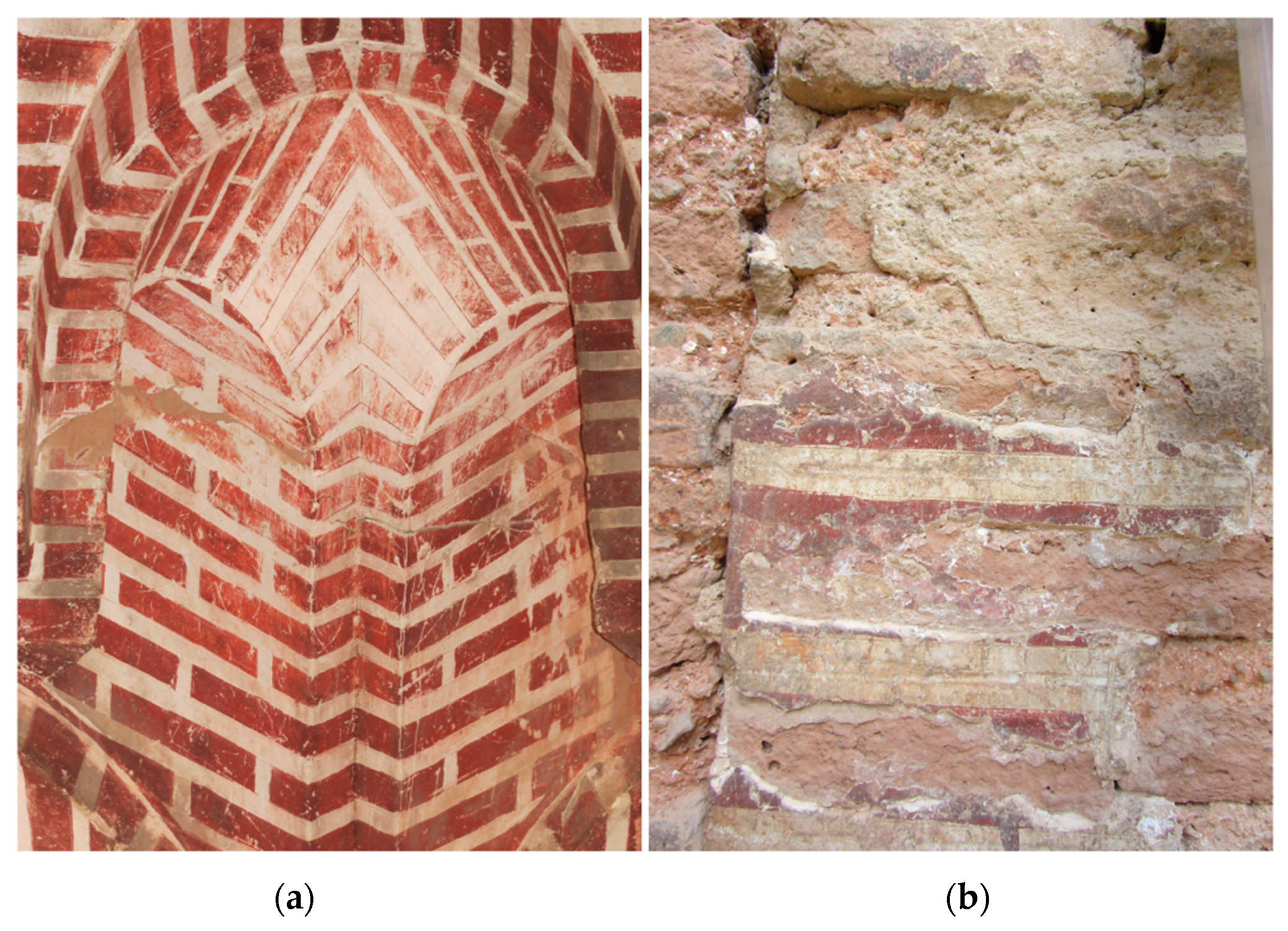
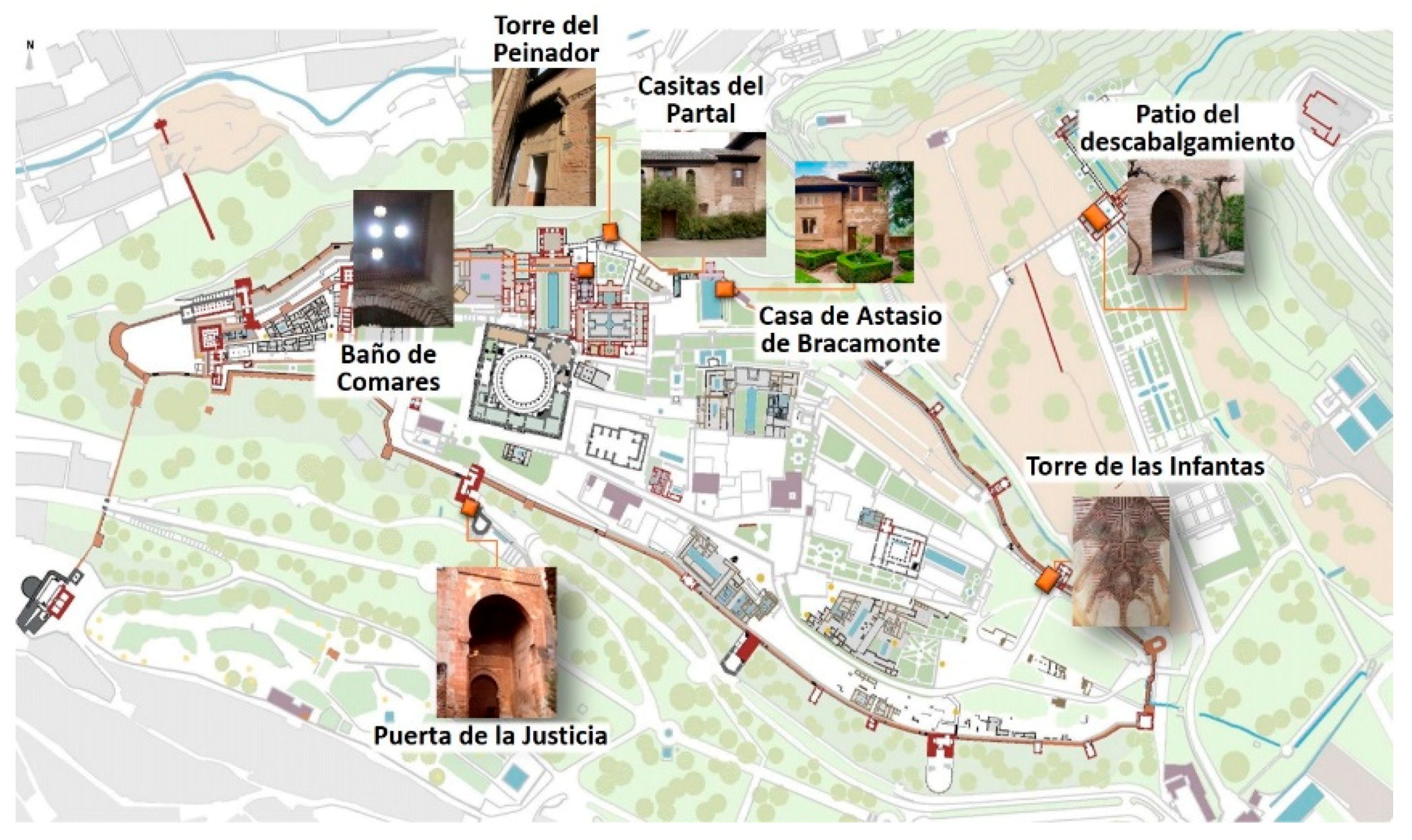
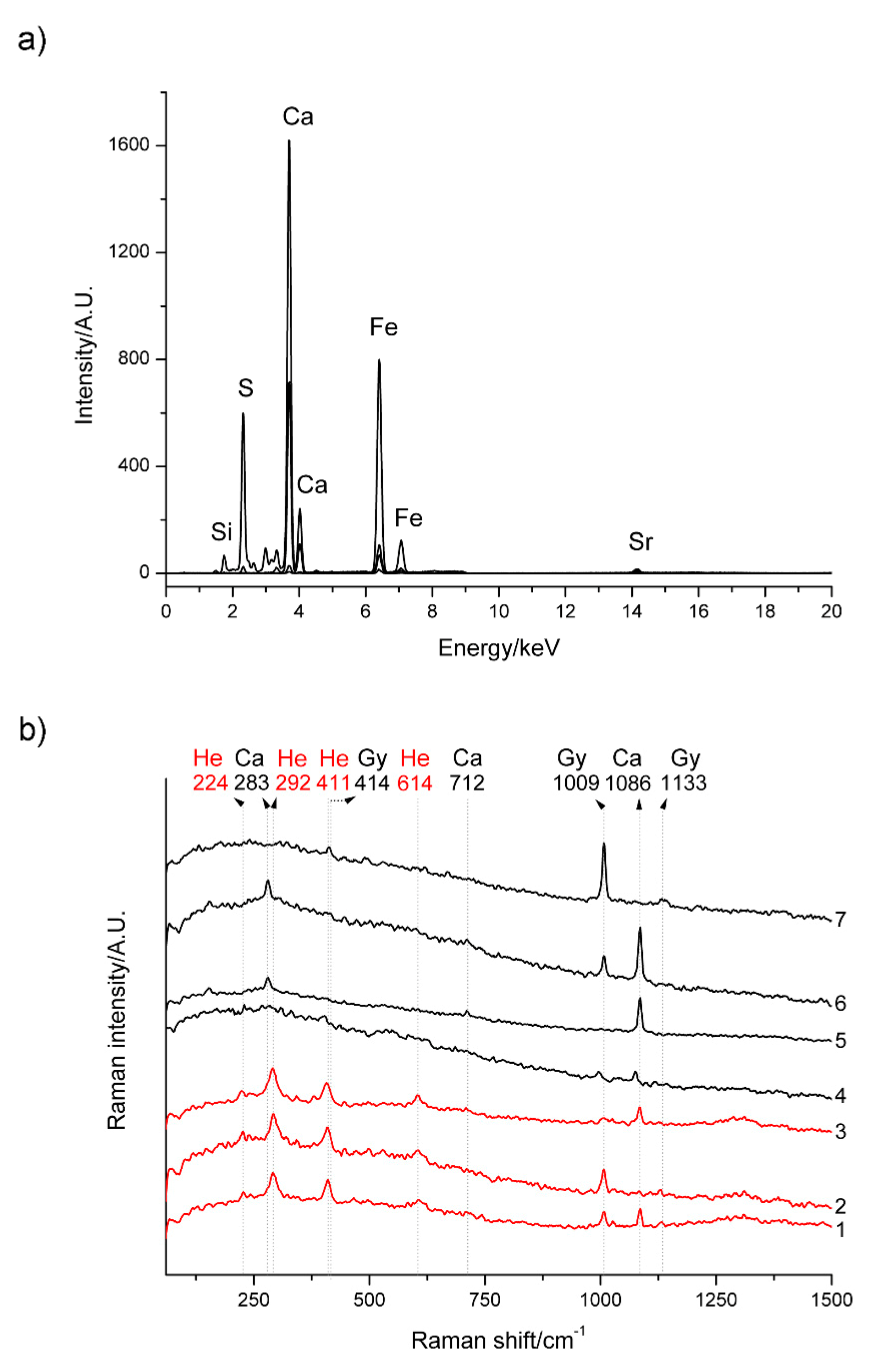
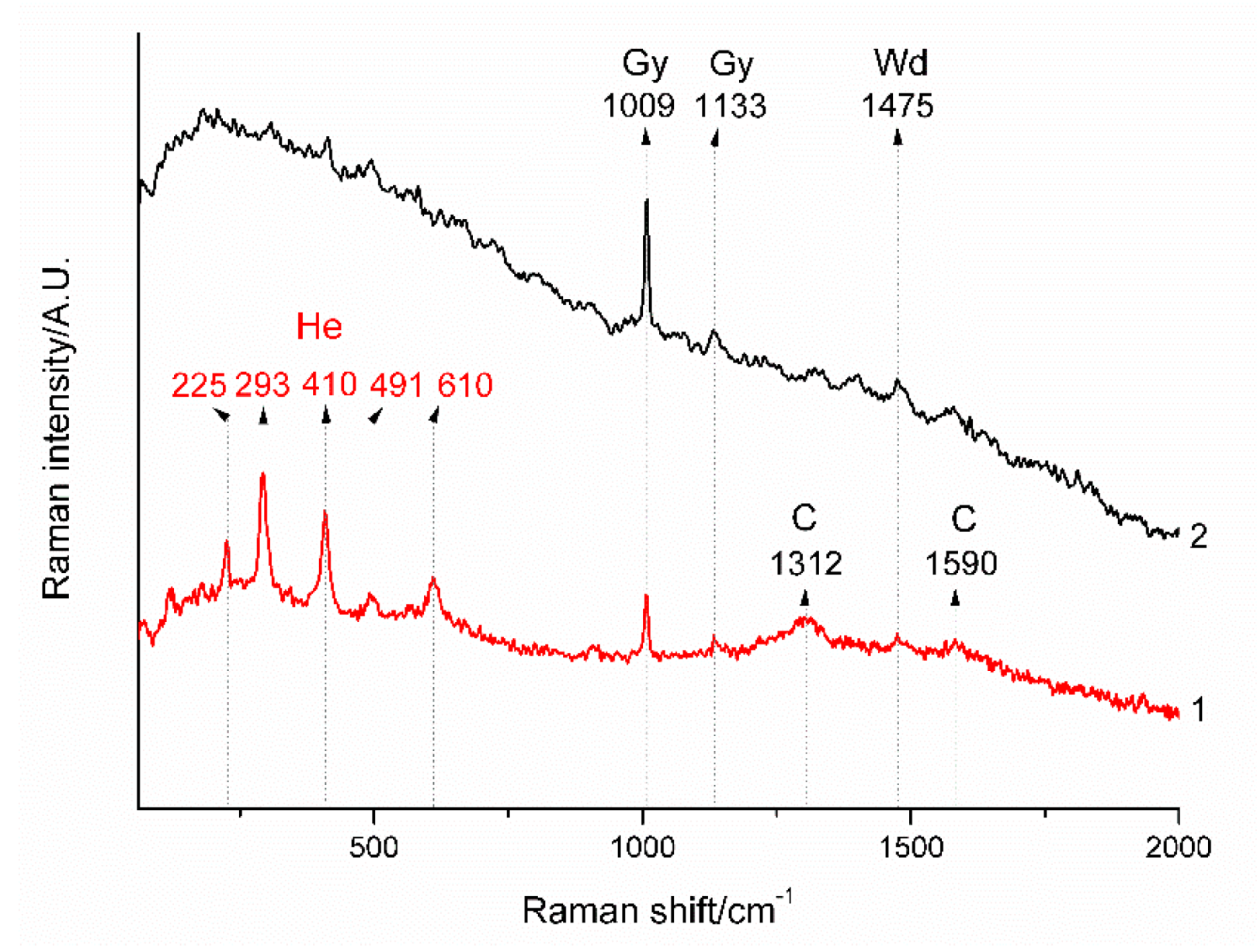
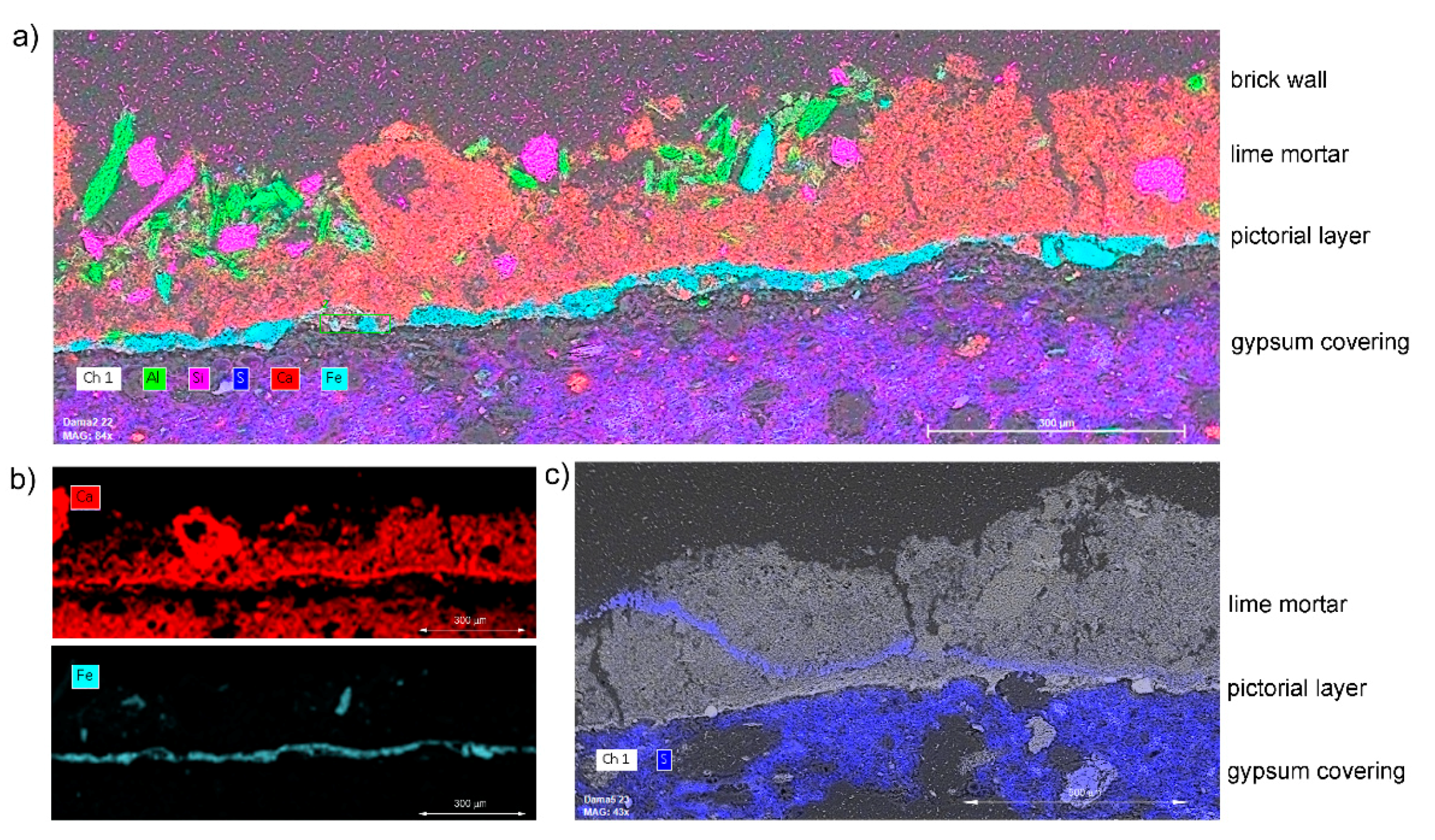
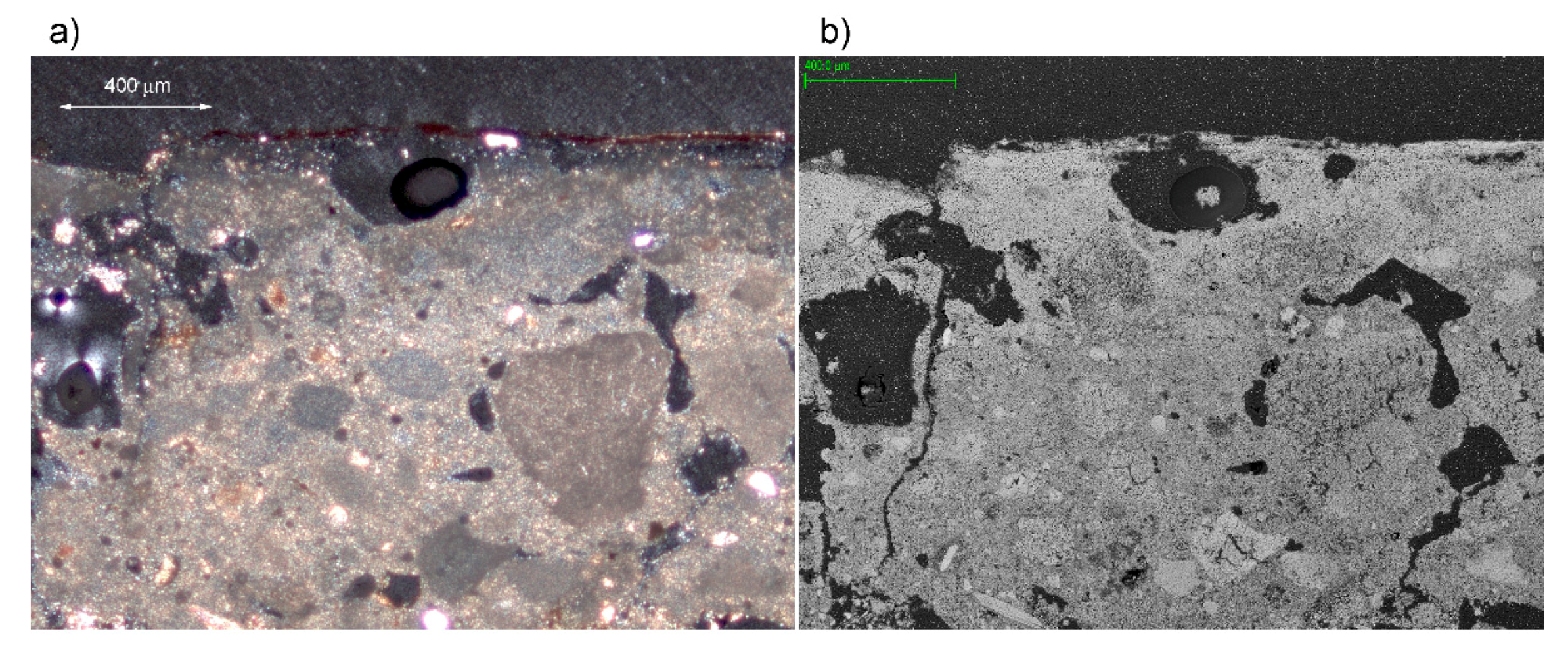
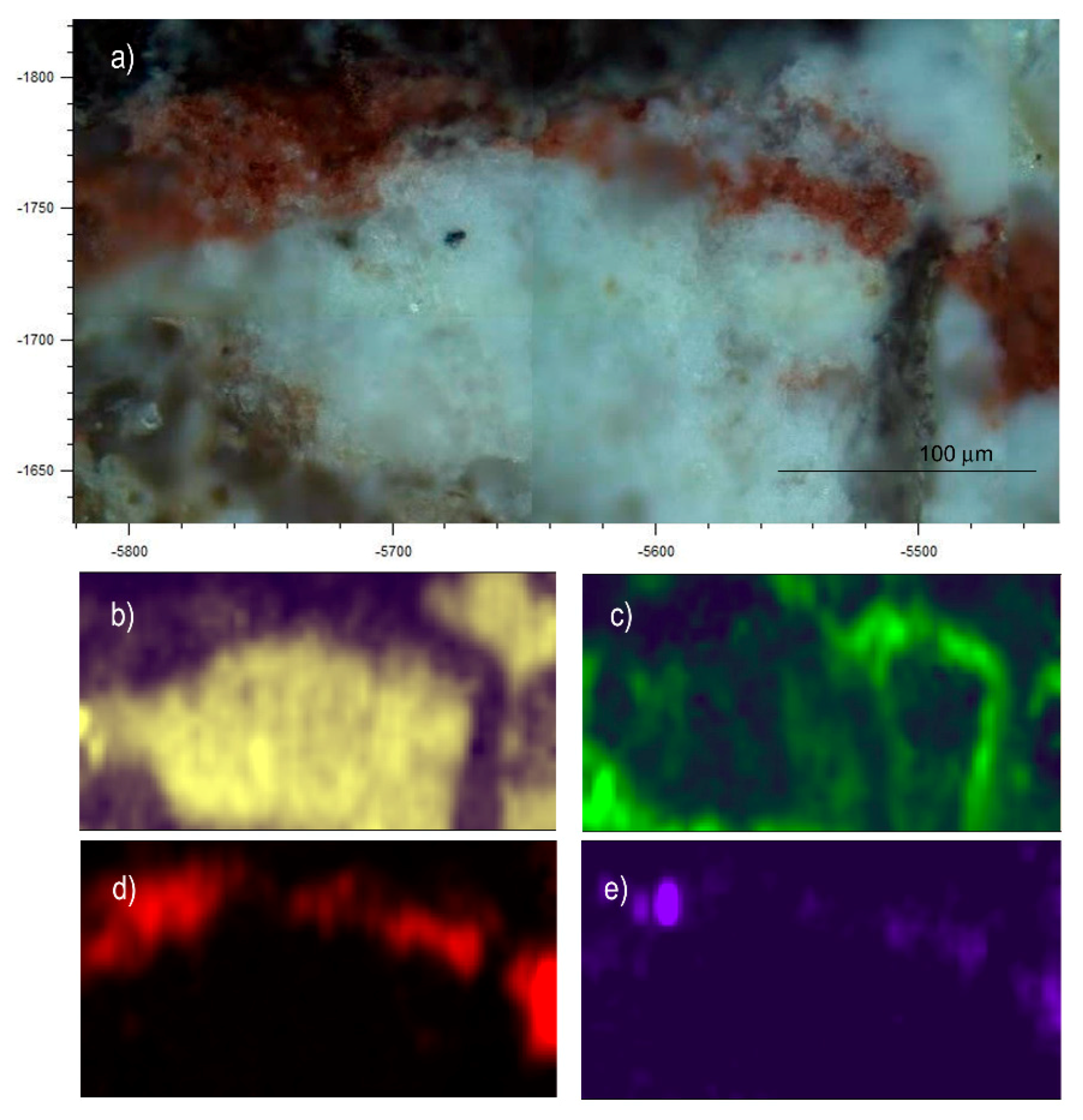

Publisher’s Note: MDPI stays neutral with regard to jurisdictional claims in published maps and institutional affiliations. |
© 2021 by the authors. Licensee MDPI, Basel, Switzerland. This article is an open access article distributed under the terms and conditions of the Creative Commons Attribution (CC BY) license (https://creativecommons.org/licenses/by/4.0/).
Share and Cite
Arjonilla, P.; Ayora-Cañada, M.J.; de la Torre-López, M.J.; Correa Gómez, E.; Rubio Domene, R.; Domínguez-Vidal, A. Spectroscopic Investigation of Wall Paintings in the Alhambra Monumental Ensemble: Decorations with Red Bricks. Crystals 2021, 11, 423. https://doi.org/10.3390/cryst11040423
Arjonilla P, Ayora-Cañada MJ, de la Torre-López MJ, Correa Gómez E, Rubio Domene R, Domínguez-Vidal A. Spectroscopic Investigation of Wall Paintings in the Alhambra Monumental Ensemble: Decorations with Red Bricks. Crystals. 2021; 11(4):423. https://doi.org/10.3390/cryst11040423
Chicago/Turabian StyleArjonilla, Paz, María José Ayora-Cañada, María José de la Torre-López, Elena Correa Gómez, Ramón Rubio Domene, and Ana Domínguez-Vidal. 2021. "Spectroscopic Investigation of Wall Paintings in the Alhambra Monumental Ensemble: Decorations with Red Bricks" Crystals 11, no. 4: 423. https://doi.org/10.3390/cryst11040423
APA StyleArjonilla, P., Ayora-Cañada, M. J., de la Torre-López, M. J., Correa Gómez, E., Rubio Domene, R., & Domínguez-Vidal, A. (2021). Spectroscopic Investigation of Wall Paintings in the Alhambra Monumental Ensemble: Decorations with Red Bricks. Crystals, 11(4), 423. https://doi.org/10.3390/cryst11040423







